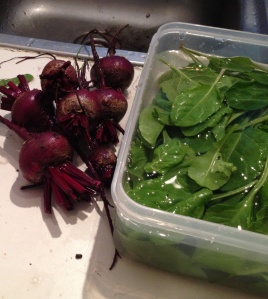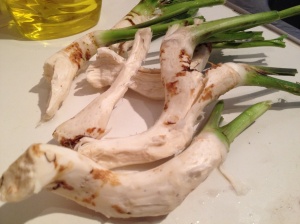After planting seeds in mid-July we reached early September, and after some slow but steady growth, we were able to begin harvesting our first vegetables.
Probably the most successful crop in terms of taste was the spinach, closely followed by the small but sweet beetroot; the radishes had a high rate of success in terms of seeds sown to crops produced; the rocket grew well in small clumps but was very bitter to the taste, possibly due to leaving it too late to harvest.
With the exception of the radishes, each of the plants/crops was smaller than expected. I think that’s partly due to the intensive commercial growing methods used by the supermarkets giving me unrealistic expectations, as well as a miscalculation on our part of how much space each plant needs to grow to it’s full potential, although I’d love to hear any alternative opinions on this.
Even so, we had managed to grow enough crops to contribute as ingredients in our meals over the next two weeks, as well as learned some interesting lessons for the future.
We also started to harvest the roots of horseradish plants growing wild in the allotment. Our ‘neighbours’ warned us of the eye-watering side effects of chopping up the root, which releases an extremely strong cloud of mustard-like gas (the neighbours recommend wearing swimming goggles during grating). Vaguely remembering how certain chemicals can be frozen to stop them from releasing vapour, I cleaned the earth from the horseradish root and put it in the freezer, which means that whenever I grate horseradish now (particularly good grated over meat and veg during roasting) the airborne burning sensation is gone, while the root stays rigid even under the most vigorous grating.
And nothing beats a rigid root.
Once we’d harvested everything that was edible (and composted whatever wasn’t) we turned over the soil and covered half the patch with mustard seeds (ordered from http://www.sowseeds.co.uk) to be grown, chopped and dug back into the soil as green manure, while the other half was left bare ready to receive a new set of crops to grow over the winter.
Meanwhile, I had ideas about what to do with the patch of wasteground at the top of our allotment…


Great idea. I’ve left mine in the ground because I couldn’t decide what to do with it… Still time to dig it up and pop it in the freezer:)
LikeLike